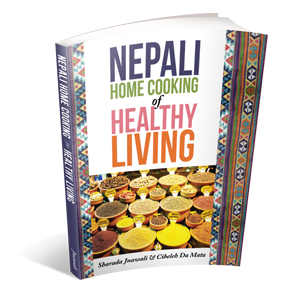By Frances Bulathsinghala
In this modern age in which the mushrooming of fast food joints has only increased the frequency of visits to the doctor, there has appeared a book entitled “Nepali Home Cooking of Healthy Living” by Sharada Jnawali and Cibeleh Da Mata, which contains Nepali vegetarian recipes which contribute to health even as they tickle the taste buds.
Sharada Jnawali, who wrote the book, holds a Masters Degree in Economics from the Tribhuvan University in Nepal and has over thirty years experience in rural development, peace-building and project management. But she is now pursuing a lifelong passion – exploring the almost limitless variety of Nepali vegetarian food, which is at once tasty and healthy.
Sharada’s aim is to globalise Nepali food, highlighting the health components of recipes that tend to be ignored in this age of standardized and fast foods.
Even a short conversation with Sharada turns into a discussion on health foods which are never far from her consciousness.Her knowledge of the diverse herbs, their nutritional value, their cultural history and the ailments they can cure, make you think of her as a herbal specialist and an ayurvedic guru.
Interestingly Sharada sees no divide between the disciplines of development, peace-building and health. She sees them all as part of the same universe of human development.
She encourages people to grow herbs, fruits and vegetables to become as agriculturally independent as possible; and points to her own backyard garden where she has grown many varieties of edible plants using natural compost as fertiliser.
Sharada says the book she embarked upon three years ago, was a bid to rejuvenate interest among Nepalis, especially the youth, in Nepali food, while also laying a foundation for creating global awareness about the nutritional value of Nepali food.
The idea of writing a book struck Sharada when she was nearing the end of a long stint at the Asian Development Bank in Nepal.
“I reverted to something which was always a part of my lifestyle,” Sharada said as she shows the mind boggling array of herbs, various commonplace as well as rare local flowers (to be used as teas) and leaves of trees and shrubs (to be used as teas or dipped in some recipe or the other), all adorning her kitchen cabinet.
All these are kept neatly in jars and are used daily in the family diet.
Asked how the book came into being, she spoke of the significance of her meeting with Cibeleh Da Mata, a Brazilian ayurvedic therapist, yoga practitioner and an organic beauty consultant in Brazil. Cibeleh, who was working in Nepal for sometime, had a fascination for the country and had contacted Sharada in 2011 to learn about Nepali vegetarian cooking, having heard of the use of medicinal herbs and spices in Nepali cooking.
Sharada and Cibeleh thus began a culinary journey which brought together two people from two different cultures who also shared a love for health foods. The duo wanted to show how humanity could benefit from traditional Nepali cooking which uses many herbs with curative properties.
Being an ayurvedic practitioner, Cibeleh was amazed to see the great variety of vegetarian dishes which could be prepared with a single ingredient. It did not take her long to become Sharada’s collaborator in the project to write a book on Nepali vegetarian recipes.
The decision to start with a book highlighting vegetarian recipes was made because Sharada was often asked by foreigners if Nepal had vegetarian food on the assumption that it is mainly a meat eating culture. Nepal is misconstrued as a meat eating nation as people do enjoy tucking into buffalo meat and pork recipes.
“I thought about what recipes I should focus on – vegetarian or non vegetarian or both. Finally, I settled for vegetarian, especially dishes that visitors and even locals are not familiar with,” she said.
The book is informative and ‘appetizing’ too, thanks to the care taken in photographing and printing. Each recipe was cooked especially for the camera, and each step is well illustrated so that the learner can pick up with ease.
“Every day, for weeks on end, we cooked these recipes in my kitchen,” Sharada recalled.
Friends from Nepal as well as other countries who were visiting in the six months that the foods were being prepared, had taken an active role in the process as part of the ‘food tasting team’. Friends from the United States, Russia, Spain, Portugal, Switzerland and Brazil had been part of this food tasting brigade, with many of the recipes they tasted being carefully noted so that they could try them out when they get back home.

Among those whose expertise and advice were sought was Dr. Navin Bastola of the Dhanawantari Ayurvedic Hospital in Kathmandu. Sharada had lengthy discussions with him on the Ayurvedic value of the recipes. As regards how the venture could be woven into tourism and Nepali food promotion, she consulted Nepal’s doyen of tourism and the hospitality industry, Karna Shakya.
On the division of labour in the production of the book, Sharada said that Cibeleh had taken the photographs and worked on the design of each page and the cover. The Australia based Xlibris publishing house took on the responsibility to being out the book.
The book is very conveniently arranged into sections and chapters. Recipes are divided into those made from rice, wheat, barley, corn, millet, buckwheat, lentils, beans and soya bean. It is further divided into recipes of common vegetables, root vegetables, and further divided into soups, milk, yogurt, achaar (pickles), fresh chutneys and beverages.
It explains the importance of each recipe in terms of health and culture. It begins with rice recipes and highlights the nutritional levels in rice, before going into traditional rice recipes such as ‘Jwanu Lasoon Rice,’ ‘Jogi Bhat mixed vegetable rice,’ It then moves on to recipes such as rice rolls and yomari followed by traditional wheat recipes such as the much loved Nepali Momos. It covers a wide range of corn as well as millet recipes.
The taste of the Chyankhla Kheer is made appealing to children so that they cultivate the habit of eating corn.Buckwheat recipes includes Buckwheat grits which contribute to reducing blood pressure and the risk of diabetes.
Lentil recipes such as Bodi Tama, made with black eyes peas and bamboo shoot, have protein and amino acid which are good for the heart. The recipe is cooked during festivals and special occasions in Nepal, Sharada said.
Among the many curry recipes are the Karkalo Kofta made from the Karkalo leaf. But it is toxic and needs to be paired off with lemon. Then there is the Rayoko Saag made from broad mustard seed. There is also a whole range of soups and salads and beverages that include asparagus, nettle and millet soup, the potato yogurt salad, eggplant salad and drinks such as Sattoo serbat (chickpeas sattoo drink).
A noticeable aspect of the book is that it has a detailed and separate section on kitchen spices and herbs, highlighting their medicinal value and use. The book also enlightens the reader on what foods or combination of foods to avoid. Also explained is the significance of the cooking pan and how it should be selected.
Asked what she hopes to write on in the future, Sharada said that she wants to work with culinary experts from South Asian countries to bring out a South Asian cookbook aimed at breaking stereotyped images of food pertaining to those countries.
Examples of stereotyping are: Nepali food is necessarily non-vegetarian; Pakistani food is oily; or Sri Lankan food is spicy.
Sharada is also mulling the idea of a book on teas that could be made with many of the ordinary flowers that one comes across in South Asia. These are ignored without realizing that they may have a medicinal value.
“I really look forward to continuing to impart knowledge on healthy lifestyles through food and drink, and to create awareness on how food can yield mental and physical dividends,” Sharada said.
“Nepali Home Cooking of Healthy Living” by Sharada Jnawali and Cibeleh Da Mata could be ordered by writing to: [email protected]





























































